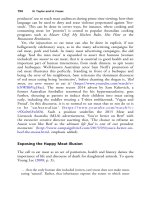The palgrave international handbook of a 215
Bạn đang xem bản rút gọn của tài liệu. Xem và tải ngay bản đầy đủ của tài liệu tại đây (34.09 KB, 1 trang )
210
A. Nurse
Table 1 UK reported collecting offences by year
Offence
Possession of dead wild birds or
taxidermy
Egg Collecting and Egg Thefts
Total
2008
2009
2010
2011
2012
2013
5
15
12
13
6
7
39
44
65
80
43
55
33
46
25
31
14
21
Source: RSPB Annual Reports on Wild Bird Crime
albeit the taking of wild birds’ eggs has been unlawful in the UK since the
introduction of the Protection of Birds Act 1954. For persons found guilty of
possession offences, Magistrates have the power to impose maximum sentences of £5,000 fine and/or six month’s imprisonment per egg.2
The prevalence of egg collecting is difficult to ascertain but in the UK
relates to a small but persistent group of offenders. In 2013 (at time of
writing the most recent year for which figures are available), the RSPB
recorded 14 reported incidents’ of egg collecting and egg thefts; a significant
reduction on previous years as shown in Table 1.
This also compares with 41 reports received in 2007, and an average
number of 66 reports received between 2003 and 2007. The RSPB argues
that the introduction of custodial sentences by the Countryside and Rights of
Way Act 2000 has had a ‘positive effect in reducing egg-collecting activity in
the UK’ (RSPB 2009) although recidivism remains a significant issue. In
England and Wales, the law also creates a strict liability offence in respect of
possessing a dead wild bird or any part of a dead wild bird (Section 1(2)(a) of
the Wildlife and Countryside Act 1981) and creates offences in relation to
selling dead wild birds (Section 6(2)(a) of the Wildlife and Countryside Act
1981). The law also makes it an offence, under Section 1(3) of the Protection
of Badgers Act 1992, for a person to possess a dead badger, or part of a dead
badger, unless he can prove that the badger had not been killed in contravention of either the Protection of Badgers Act 1992, or its predecessor, the
Badgers Act 1973.
While space does not permit a detailed discussion of the UK, the USA or
international law concerning the possession of live or dead animals, these
examples illustrate how wildlife protection law addresses some aspects of
collecting activity, classifying them as undesirable and prohibited activities.
Schaffner (2011, p. 189) argues that generally current law ‘allows humans
to use animals for a variety of purposes including breeding and confining
2
Sentencing information correct at the time of writing.









